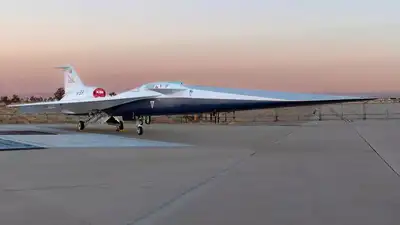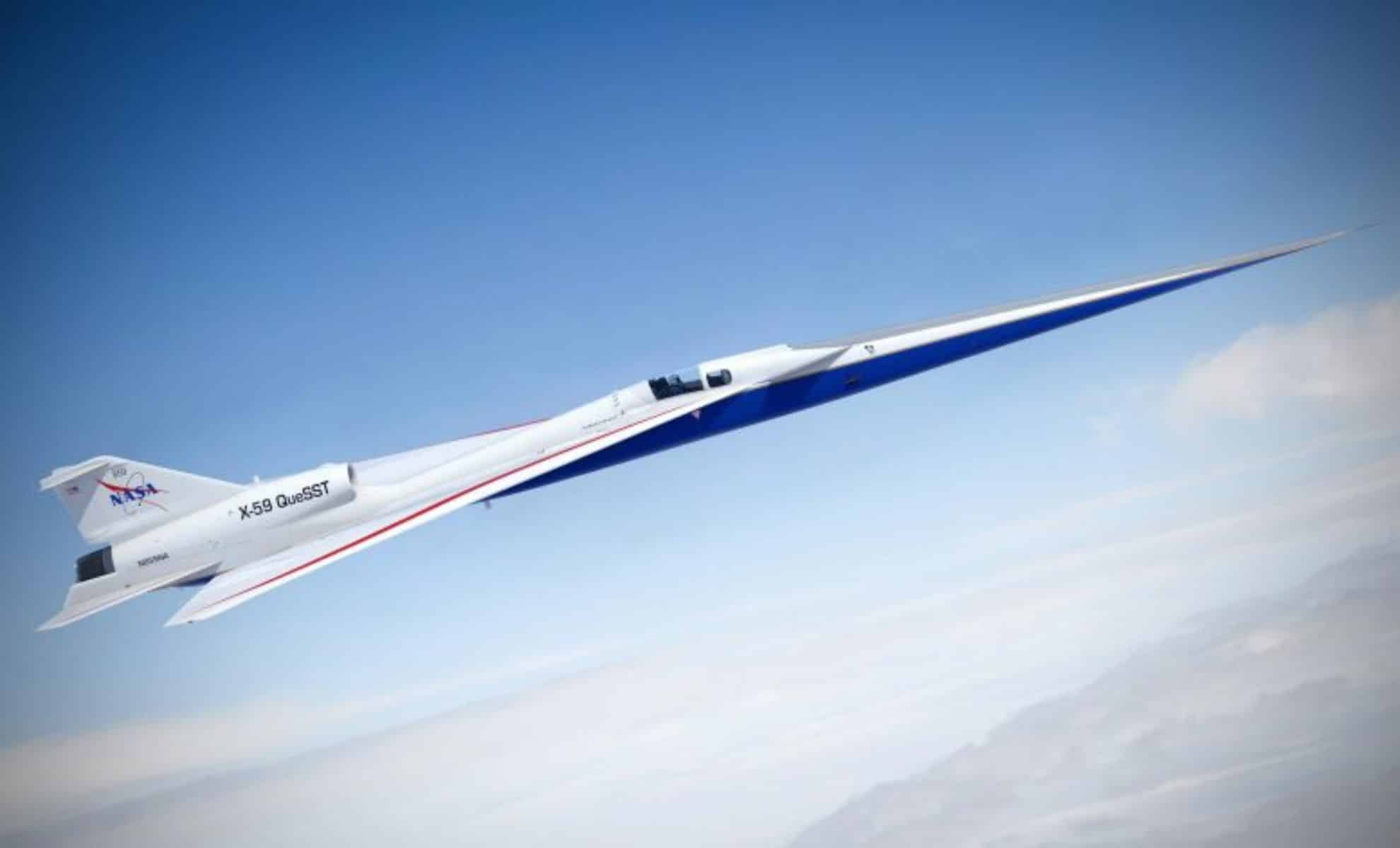Palmdale, California – July 10, 2025, 10:00 AM PST
NASA’s X-59 Quiet Supersonic Technology (QueSST) aircraft, designed to revolutionize air travel by dramatically reducing the sonic boom to a mere “thump,” successfully completed its initial low-speed taxi tests at the U.S. Air Force’s Plant 42 facility in Palmdale, California. This momentous event marks a crucial step in the X-59’s journey towards its highly anticipated first flight, expected later this year.
The 99.7-foot-long experimental jet, a collaboration between NASA and Lockheed Martin Skunk Works, moved under its own power across the runway, demonstrating the functionality of its fundamental ground handling, steering, and braking systems. NASA test pilot Nils Larson was at the controls, meticulously evaluating the aircraft’s responses. Engineers from both NASA and Lockheed Martin monitored the systems in real-time, ensuring every component functioned precisely as intended. These low-speed taxi tests are the final phase of ground trials before the X-59 progresses to high-speed taxiing, where it will accelerate to speeds just shy of takeoff, and ultimately, its maiden flight.
A New Era of Supersonic Travel
The successful “first test drive” of the X-59 is not merely a technical achievement; it signals a potential paradigm shift in commercial aviation. For decades, supersonic flight over land has been largely prohibited in many parts of the world due to the disruptive and often damaging sonic booms generated by aircraft breaking the sound barrier. The iconic Concorde, while a marvel of engineering, was ultimately grounded in part due to these noise restrictions and high operational costs. NASA’s Quesst mission, with the X-59 at its core, aims to overcome this critical barrier by demonstrating a new generation of supersonic aircraft that can fly faster than sound without creating a deafening boom.

The X-59’s unique, elongated design, including its distinctive 38-foot-long nose and specially shaped fuselage, is engineered to prevent the shock waves typically associated with supersonic flight from coalescing into a loud boom. Instead, the aircraft is designed to produce a gentle “sonic thump” – a sound no louder than a car door closing from a distance. This innovative approach is crucial for potentially lifting the long-standing ban on commercial supersonic flight over land, which was implemented in the U.S. in 1973.
Technological Marvel and Design Ingenuity
The X-59 is a testament to cutting-edge aerospace engineering. Its slim profile and carefully sculpted surfaces are the result of extensive computational fluid dynamics modeling and wind tunnel testing. The aircraft is powered by a single General Electric F414-GE-100 engine, a modified variant of the engine used in F/A-18 fighter jets, mounted on top of the fuselage to further minimize noise reaching the ground. This engine produces approximately 22,000 pounds of thrust, enabling the X-59 to achieve a cruising speed of Mach 1.42 (approximately 937 mph or 1,510 km/h) at an altitude of 55,000 feet.
One of the most striking features of the X-59 is the absence of a traditional forward-facing cockpit window. Due to its long, pointed nose, the pilot’s forward vision would be completely obstructed. To overcome this, the X-59 utilizes an innovative “External Vision System” (XVS). This augmented reality-enabled closed-circuit camera system provides the pilot with a high-resolution, 4K view of what’s ahead, combining images from cameras mounted on the aircraft’s exterior with graphics displaying flight path information, airspeed, and other critical data. This technology is a significant step forward in aircraft design, demonstrating how advanced digital systems can compensate for traditional design limitations.
While the X-59 itself is an experimental aircraft and not intended for commercial passenger service, the data it collects will be invaluable. The Quesst mission plans to fly the X-59 over selected communities in the U.S. beginning in 2026. During these flights, NASA will gather critical data on how residents perceive the quieter “sonic thumps.” This community response data, along with acoustic measurements and performance data, will then be shared with the U.S. and international aviation regulators, such as the Federal Aviation Administration (FAA) and the International Civil Aviation Organization (ICAO). The ultimate goal is to provide regulators with the scientific evidence needed to establish new, data-driven acceptable noise thresholds, potentially paving the way for a new era of commercial supersonic travel over land.
From Ground Tests to the Skies and Beyond
The low-speed taxi tests conducted on July 10, 2025, are a pivotal milestone, but they are just one step in a comprehensive test campaign. Prior to this, the X-59 underwent a series of rigorous ground tests, including engine run tests where its General Electric F414-GE-100 engine was powered up to full afterburner in January 2025, electromagnetic interference (EMI) testing in February 2025 to ensure its onboard systems function without interference, and “engine speed hold” tests in April 2025 to verify cruise control capabilities. In May 2025, NASA also conducted simulated in-flight conditions, including failure scenarios, by feeding data into the aircraft’s computers on the ground. Recent wind tunnel tests with a scaled model in Japan, in collaboration with the Japan Aerospace Exploration Agency (JAXA), have further validated the predictions for the X-59’s “quiet” sonic signature.
With the successful completion of low-speed taxiing, the team will gradually increase the aircraft’s speed during subsequent high-speed taxi tests. If all systems continue to perform flawlessly, NASA will give the green light for the X-59’s maiden flight. This initial flight will focus on basic airworthiness and flight envelope expansion, ensuring the aircraft handles as expected in the air. Following these initial flight tests, the X-59 will embark on its groundbreaking acoustic validation flights, flying at supersonic speeds over instrumented test ranges to precisely measure its sound signature.
The potential implications of the X-59’s success are vast. Reintroducing supersonic commercial travel could dramatically reduce flight times, making transcontinental journeys significantly faster. Imagine a future where a flight from New York to London takes just three and a half hours, opening up new possibilities for business, tourism, and global connectivity. While the X-59 is a research aircraft, its mission is to gather the data and develop the design tools necessary for aerospace companies to eventually build quiet supersonic passenger jets, ushering in a new golden age of air travel, where speed no longer comes at the cost of disruptive noise. The world watches with anticipation as the X-59 moves closer to transforming the skies.




